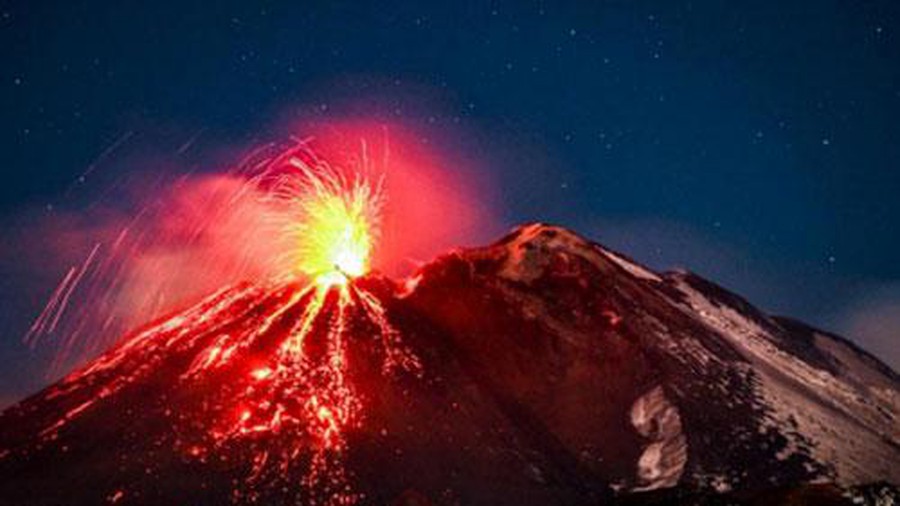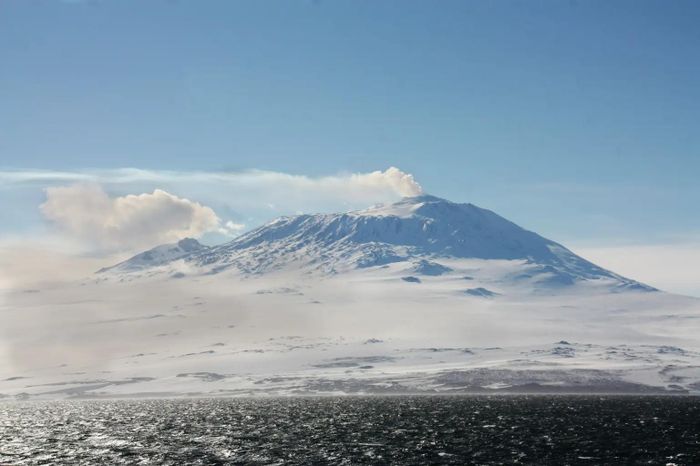Why observing trees near volcanoes is a great early warning image
Scientists have discovered that trees near volcanoes often change color when the volcano becomes more active. Recently, a team of researchers from NASA and the Smithsonian Institution (USA) collaborated to conduct a study to monitor these changes from space.
The results showed that before the volcano erupted, magma rose from the ground, releasing gases such as carbon dioxide (CO₂) and sulfur dioxide (SO₂). The plants absorbed the CO₂, causing their leaves to become greener and thicker. Scientists used satellite imagery from NASA's Landsat 8 and data from the Airborne Validation Unified Experiment: Land to Ocean (AVUELO) aircraft to detect this phenomenon.
' This all-natural early warning system for volcanic eruptions is highly reliable, ' said Florian Schwandner, chief of Earth Sciences at NASA's Ames Research Center. ' The goal here is to improve observations and provide earlier warnings. '

Volcanic eruptions are dangerous and unpredictable. About 10% of the world's population lives in areas that could be affected. People near volcanoes face risks such as flying rocks, ash clouds, and toxic gases. Even people far away can experience mudflows or tsunamis from eruptions. Because eruptions cannot be prevented, early warning is crucial.
Monitoring volcanic activity from space isn't easy. Scientists can detect SO₂ because it's easier to measure, but CO₂ from volcanoes – the earliest sign of rising magma – is harder to measure. ' A volcano emitting a small amount of CO₂ that signals an eruption won't show up well on satellite images, ' explains Robert Bogue, a volcanologist at McGill University.
Traditionally, researchers have had to travel to volcanoes to measure CO₂ directly. But with more than 1,300 potentially active volcanoes around the world – many of them in remote, isolated areas – monitoring the response of plants has become a simpler, yet still accurate, solution.
Nicole Guinn, a volcanologist at the University of Houston, used satellite imagery from Landsat 8, NASA's Terra satellite, and ESA's Sentinel-2 to study vegetation near Sicily's Mount Etna. Her research found a clear link between leaf color and CO₂ from the volcano.
To confirm the accuracy of the satellite imagery, climate scientist Josh Fisher led another field study in March 2025. His team measured CO₂ and collected leaf samples near the Rincón de la Vieja volcano in Costa Rica. ' This study is an interdisciplinary combination of ecology and volcanology, ' Fisher said.
Of course, using trees as indicators of volcanic eruptions has its limitations. Some volcanic areas do not have many trees around them, and environmental factors such as weather or plant diseases can affect tree growth. But past success shows the potential of this approach.
You should read it
- Close up of the scene of the horrifying explosion of the super volcano, engulfing the whole city
- The Earth will cool when volcanic eruptions on Bali island erupt
- Close up of the Agung volcano in Bali erupts 4000m smoke pillars into the air
- What is the loudest sound on Earth? What makes the loudest sound on Earth?
- Decipher the world's most dirty volcano that spits rotten mud instead of lava
- On volcanic islands, landslides can cause huge eruptions
- Indonesian volcano erupted, creating a column of smoke as high as nearly 200 meters
- Stunned the impressive moment when lightning struck the crater that was erupting
May be interested
- Science explains why Venus has so few volcanoes
 researcher sami mikhail has just released the latest claims explaining why venus has so few volcanoes.
researcher sami mikhail has just released the latest claims explaining why venus has so few volcanoes. - See active volcanoes around the world
 volcanoes help scientists decipher the inner workings of our planet and how eruptions form life on the surface of the earth. each time a volcano erupted, it was a fiery display of the power of the earth.
volcanoes help scientists decipher the inner workings of our planet and how eruptions form life on the surface of the earth. each time a volcano erupted, it was a fiery display of the power of the earth. - Rare volcano spits out real gold
 an active volcano in antarctica not only erupts material like other volcanoes, but also spews gold dust into the atmosphere every day, according to ifl science.
an active volcano in antarctica not only erupts material like other volcanoes, but also spews gold dust into the atmosphere every day, according to ifl science. - 20+ images demonstrate eloquently about the vitality of trees
 join us to admire 20+ powerful demonstrations of the vigorous vitality of trees to stop complaining and keep trying!
join us to admire 20+ powerful demonstrations of the vigorous vitality of trees to stop complaining and keep trying! - Macromedia Flash - Pinwheel hill
 a cute image as in animation with a simple hill ramp and several pinwheel trees. you will see that to create that image is not difficult at all with this tutorial.
a cute image as in animation with a simple hill ramp and several pinwheel trees. you will see that to create that image is not difficult at all with this tutorial. - Mango trees are 1m high with 800 fruits in Japan
 the most special mango tree in the world is only 1m high but has a canopy diameter of up to 10m and parked up to 800 fruits, making the most fruitful record in the region and the whole japan surprised many people.
the most special mango tree in the world is only 1m high but has a canopy diameter of up to 10m and parked up to 800 fruits, making the most fruitful record in the region and the whole japan surprised many people. - The mysterious witch forest in England
 kingley vale national nature reserve in southern england is famous for its witch forest of nearly 1,000-year-old ancient pine trees full of mysterious and gruesome forms that frighten and curious people .
kingley vale national nature reserve in southern england is famous for its witch forest of nearly 1,000-year-old ancient pine trees full of mysterious and gruesome forms that frighten and curious people . - The researchers first obtained the volcano's 'thunder'
 in august 2016 and 2017, the recording microphone system recorded sounds from volcanoes on bogoslof island, part of alaska's aleutian islands. analyzing the logs shows a strange sound like a volcano's thunder.
in august 2016 and 2017, the recording microphone system recorded sounds from volcanoes on bogoslof island, part of alaska's aleutian islands. analyzing the logs shows a strange sound like a volcano's thunder. - Guide 10 ways to make Christmas tree unique from any material
 with handmade pine trees you can transform the size to small size to suit the purpose of using from decorating the house to making a christmas gift for friends and relatives without worrying about being hit.
with handmade pine trees you can transform the size to small size to suit the purpose of using from decorating the house to making a christmas gift for friends and relatives without worrying about being hit. - 7 absolute habits should not be done after waking up in the morning
 get up early but still do not change these 7 habits, your morning is still very tired and just want to go back to bed to ... continue to sleep.
get up early but still do not change these 7 habits, your morning is still very tired and just want to go back to bed to ... continue to sleep.










 The cutest little animals in the world
The cutest little animals in the world Glowing pink owl wings may be sending secret messages
Glowing pink owl wings may be sending secret messages African black-footed cat: Looks innocent but is the 'world's most dangerous' cat
African black-footed cat: Looks innocent but is the 'world's most dangerous' cat Strange facts about eels you may not know
Strange facts about eels you may not know Dire Wolf: Scientists successfully revive ancient wolf species
Dire Wolf: Scientists successfully revive ancient wolf species Close-up of the baby iguana's spectacular escape from a pack of ferocious snakes surrounding it
Close-up of the baby iguana's spectacular escape from a pack of ferocious snakes surrounding it